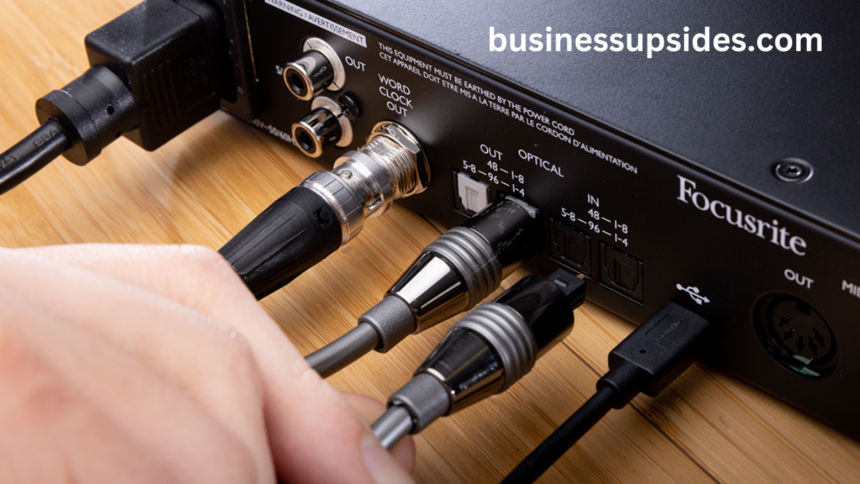Focusrite audio interfaces have earned a solid reputation for delivering high-quality sound and seamless integration with various digital audio workstations (DAWs). Whether you’re a budding music producer, a seasoned audio engineer, or simply looking to improve your audio setup, a Focusrite interface is often a reliable choice. However, like all electronic devices, things don’t always go smoothly. One common issue that users face is when their focusrite not registering audio devices. This can be frustrating, particularly when you need to get work done. Fortunately, there are several ways to troubleshoot and resolve this issue.
In this article, we will explore the potential reasons why your Focusrite audio interface is not registering audio devices and provide actionable solutions to fix the problem.
Understanding the focusrite not registering audio devices
Before we dive into troubleshooting, let’s briefly review what a Focusrite audio interface does and how it operates. The Focusrite interface allows you to connect various audio sources (e.g., microphones, instruments, and other line-level devices) to your computer via USB. The device converts analog audio signals into digital data, which your DAW (Digital Audio Workstation) or other recording software can process.
Typically, Focusrite interfaces feature:
- Inputs and Outputs for connecting microphones, instruments, headphones, and monitors.
- USB connectivity to interface with the computer.
- Pre-amps to amplify the signal from microphones or instruments.
- Control software for routing audio signals and managing settings (e.g., Focusrite Control).
When the focusrite not registering audio devices, it can result in no sound or the device not being recognized at all by the computer or DAW. Let’s explore the most common causes of this issue and solutions to resolve it.
1. Check the Physical Connections
The first step when troubleshooting any audio device is to ensure that all physical connections are properly made. Here are some checks to perform:
a) USB Connection
Make sure that the Focusrite interface is securely connected to your computer via USB. If using a USB hub, try connecting the interface directly to a USB port on your computer. Sometimes, USB hubs do not supply enough power or bandwidth for audio interfaces.
Additionally, if you’re using a USB 3.0 port, try switching to a USB 2.0 port, as some Focusrite interfaces are known to work better with USB 2.0 for stability.
b) Audio Cables focusrite not registering audio devices
Ensure that the correct cables are used to connect your microphone, guitar, or other audio devices to the Focusrite interface. If you’re using an XLR cable for a microphone, make sure the cable is in good condition and properly plugged into both the microphone and the interface. For instruments or line-level devices, ensure the TRS or TS cables are properly inserted into the relevant inputs.
c) Power Supply
If your Focusrite interface has an external power supply, make sure it’s properly connected. Some Focusrite devices rely solely on USB power, while others may have a separate power source.
2. Restart the Devices
Sometimes, issues with audio interfaces can be solved with a simple restart. This is particularly important after any changes to your setup or system, such as updates or new installations.
- Restart your computer to refresh any system settings that may be causing the issue.
- Restart the Focusrite interface by disconnecting it from the USB port, waiting for a few seconds, and then reconnecting it.
- If you’re using a software application (DAW), restart the DAW and check if the interface is detected.
3. Check for Driver and Firmware Updates
Outdated or missing drivers can prevent your focusrite not registering audio devices properly. Focusrite regularly releases updates for both the drivers and firmware, which may resolve bugs or compatibility issues with newer operating systems.
a) Installing Drivers
If you haven’t installed the latest drivers for your Focusrite device, you can download them directly from the Focusrite Downloads page. Focusrite interfaces usually require specific drivers for both macOS and Windows operating systems.
On Windows, drivers are essential to get the interface recognized and functioning properly, as Windows doesn’t automatically install the necessary drivers for audio devices like macOS does. On macOS, drivers are sometimes not required, especially for newer versions, but using the latest software version will ensure optimal performance.
b) Updating Firmware
Firmware updates can be crucial to address specific issues that might be affecting your Focusrite interface. Firmware updates may resolve known bugs, improve compatibility, and optimize performance. To check if there is a firmware update available, download the Focusrite Control software and follow the on-screen instructions to update the firmware.
c) Driver Reinstallation focusrite not registering audio devices
If the drivers were recently installed but aren’t functioning as expected, try reinstalling them. To do this, first, uninstall the current drivers from your computer. Afterward, download the latest version from the Focusrite website and reinstall them.
Previous article; Troubleshooting Guide Vland Ram 1500 Drl wont turn off
4. Ensure the Focusrite Device is Selected as the Default Audio Device
If the Focusrite interface is not registering audio devices, it could be because your computer is not selecting it as the default input or output device.
a) Windows
- Right-click on the speaker icon in your taskbar and select Sounds.
- Go to the Recording tab and locate your Focusrite device.
- Set it as default by right-clicking and selecting Set as Default Device.
- Similarly, go to the Playback tab and select your Focusrite device as the default output.
b) macOS
- Go to System Preferences and open Sound.
- Under the Input and Output tabs, select your Focusrite device.
- Ensure that the Output volume is set appropriately and the Input level is receiving sound.
By setting the Focusrite device as the default for both input and output, your computer will automatically use it for audio processing.
5. Configure Input/Output Settings in Focusrite Control
Most Focusrite devices come with dedicated configuration software called focusrite not registering audio devices. This software allows you to route audio, adjust input/output settings, and manage the overall operation of your interface.
a) Open Focusrite Control
Open the Focusrite Control software and make sure the input channels are configured correctly. Sometimes, input channels can be muted or set to an incorrect routing, leading to no audio being received by your DAW.
b) Check for Mute or Gain Issues
Ensure that the input gain for each connected device (microphone, instrument, etc.) is set to an appropriate level. Additionally, check that the input is not muted. It’s also a good idea to check the output levels to ensure the signal is being sent to the connected speakers or headphones.
c) Update Input Routing
If your Focusrite interface has multiple inputs (e.g., for multiple microphones or instruments), ensure that each input is routed correctly within the Focusrite Control software. You can also use the software to monitor signal levels and adjust other parameters for each input.
6. Check DAW Settings and Compatibility
If your Focusrite interface is properly connected, the drivers are installed, and Focusrite Control is configured, but the device still doesn’t register in your DAW, you may need to review your DAW settings.
a) Select Focusrite as the Input/Output Device in DAW
Every DAW allows you to select which input and output devices to use. In your DAW, go to the audio preferences or settings and choose your Focusrite interface as both the input and output device.
b) Check Buffer Size and Latency focusrite not registering audio devices
If the buffer size is set too low or too high, it can lead to issues with audio devices not being registered or functioning correctly. Try adjusting the buffer size to a higher value and check if the issue persists.
c) Test with Another DAW
To rule out a DAW-specific issue, try using a different DAW (such as Audacity, Logic Pro, Ableton Live, or Cubase). This helps to determine whether the issue lies with the DAW settings or the interface itself.
7. Test with Different USB Ports or Another Computer
If the problem persists, try connecting the Focusrite interface to a different USB port or even another computer. This helps to rule out potential issues with the USB port or the computer’s operating system.
a) Test USB Port
Sometimes, the USB port itself could be faulty. Try using another USB port on your computer to see if the device registers. Avoid using USB hubs, as these can sometimes cause connectivity issues with audio interfaces.
b) Test on Another Computer
If possible, try connecting the Focusrite device to a different computer. This can help you determine if the problem is isolated to your computer or if it’s an issue with the interface itself.
8. Reset Focusrite Interface to Default Settings
If nothing else works, consider resetting your focusrite not registering audio devices to its factory default settings. Resetting the device can help clear out any settings or configurations that might be causing the problem.
To reset the Focusrite interface, you can follow the steps outlined in the user manual or through Focusrite Control.
9. Contact Focusrite Support
If you’ve tried all the troubleshooting steps above and your Focusrite interface is still not registering audio devices, it may be time to contact Focusrite’s customer support team. They can offer advanced troubleshooting steps, confirm if there’s a hardware issue, and help you resolve the problem.
Focusrite support can be reached via email or phone, and they can assist you with warranty claims if your device is still under warranty.
Conclusion
When your focusrite not registering audio devices, it can be a source of frustration, but the issue is often solvable through proper troubleshooting. By following the steps outlined in this article—checking physical connections, restarting devices, updating drivers, configuring settings, and testing with different ports and computers—you can resolve most common issues.
Remember to always keep your drivers and firmware up to date, and if all else fails, don’t hesitate to contact Focusrite support for further assistance. With patience and the right troubleshooting steps, you should be able to get your Focusrite interface back to full functionality in no time.



